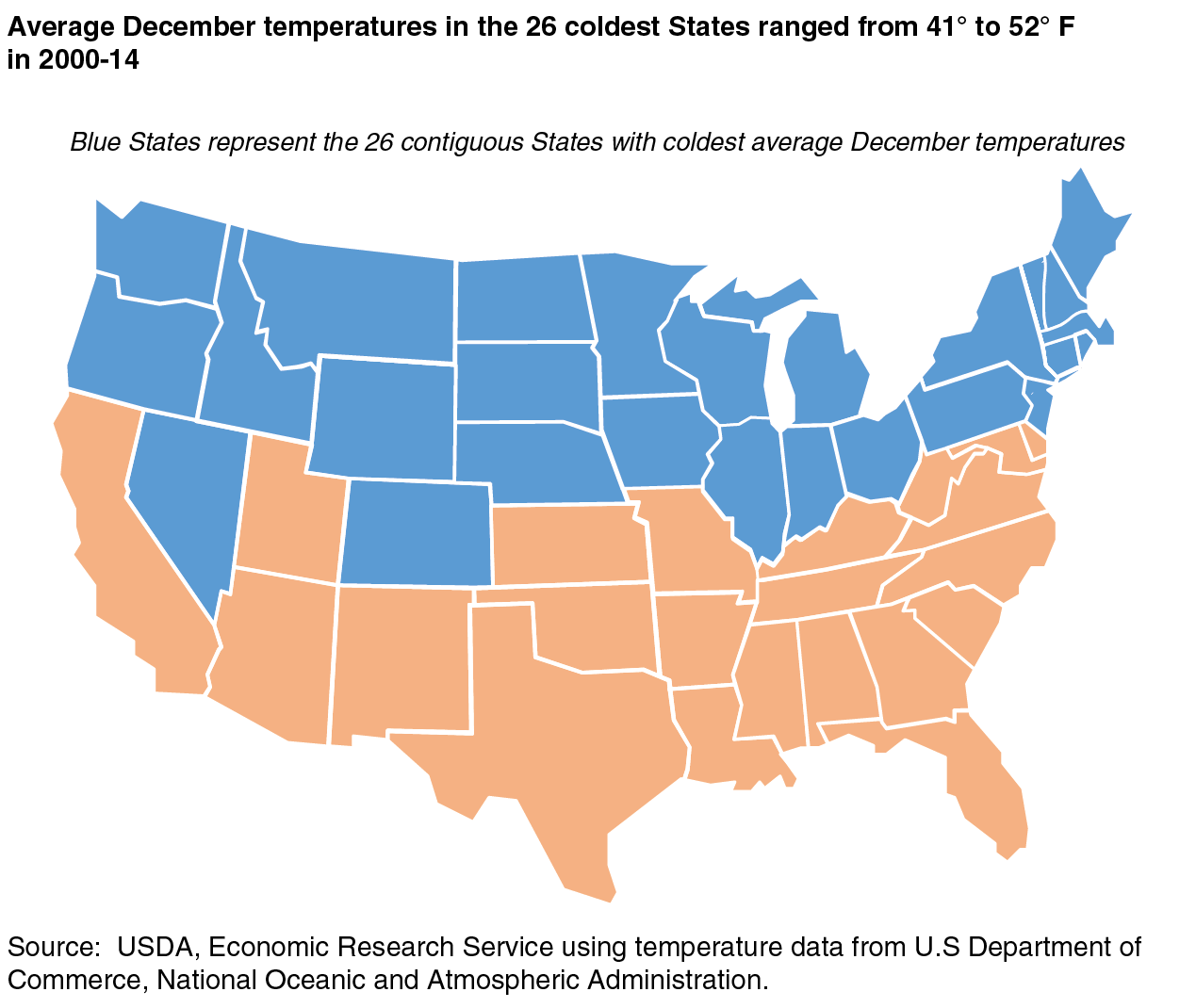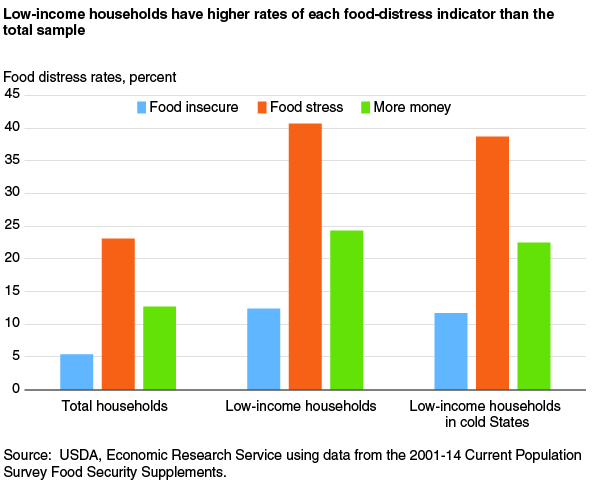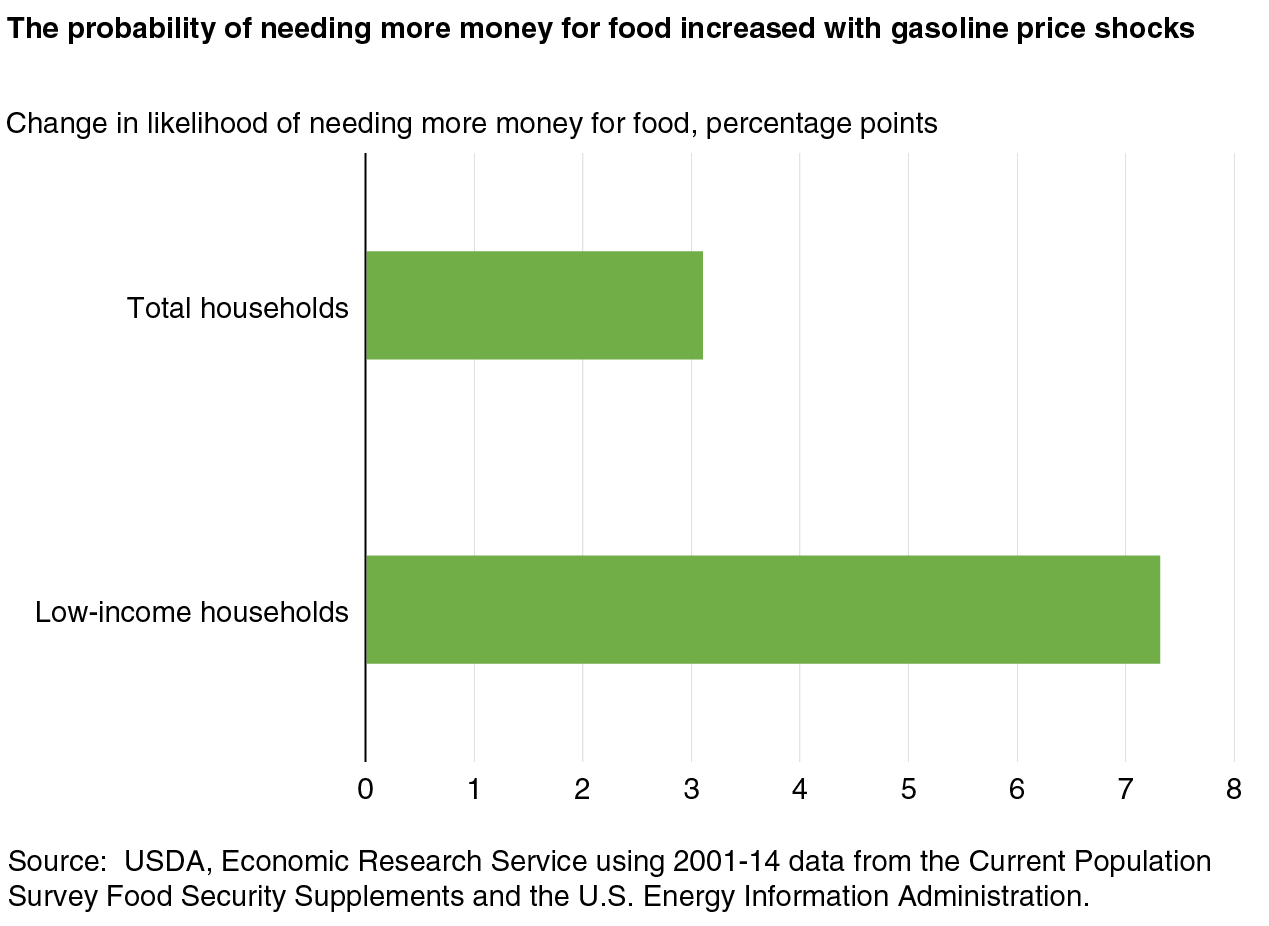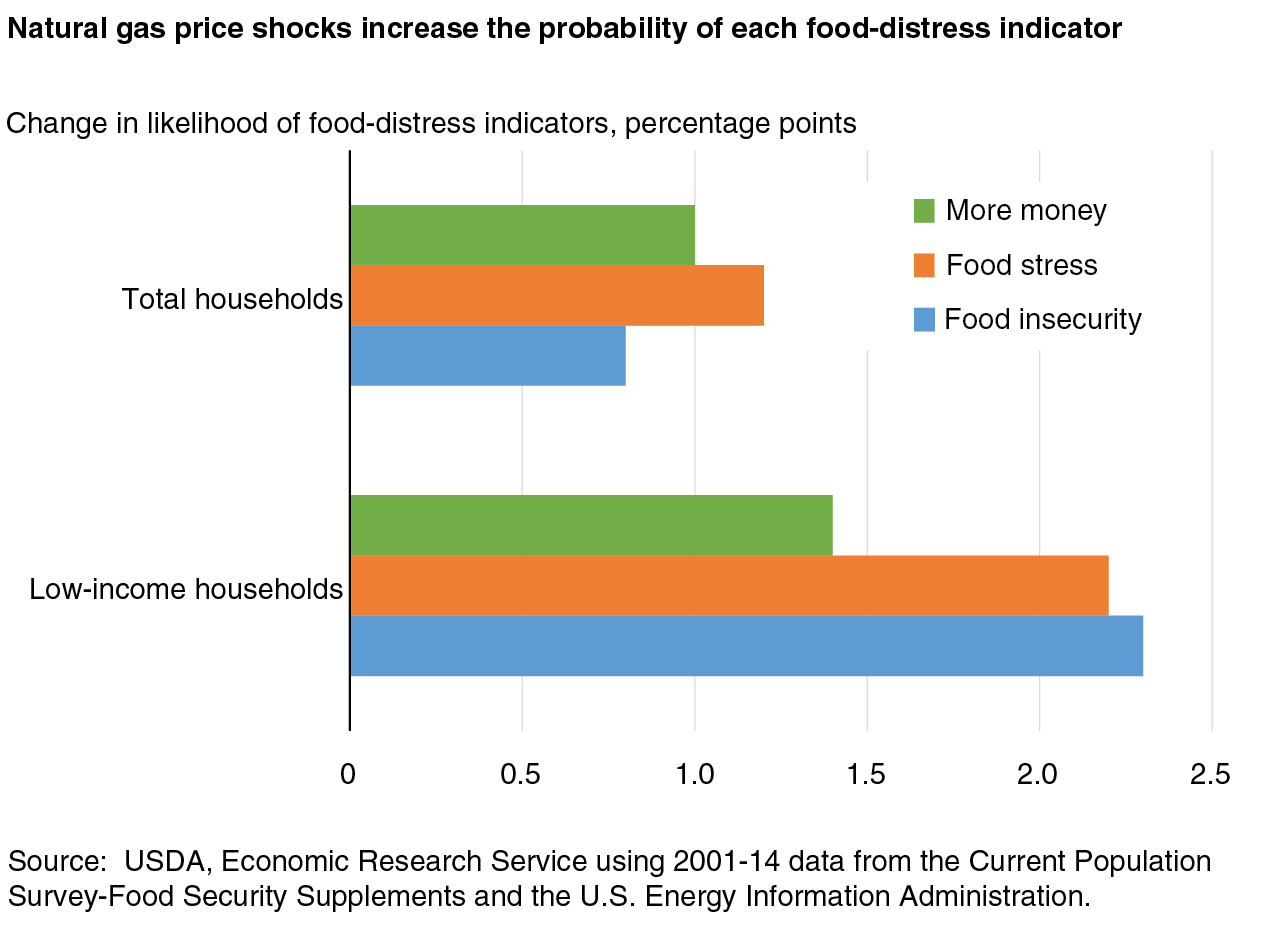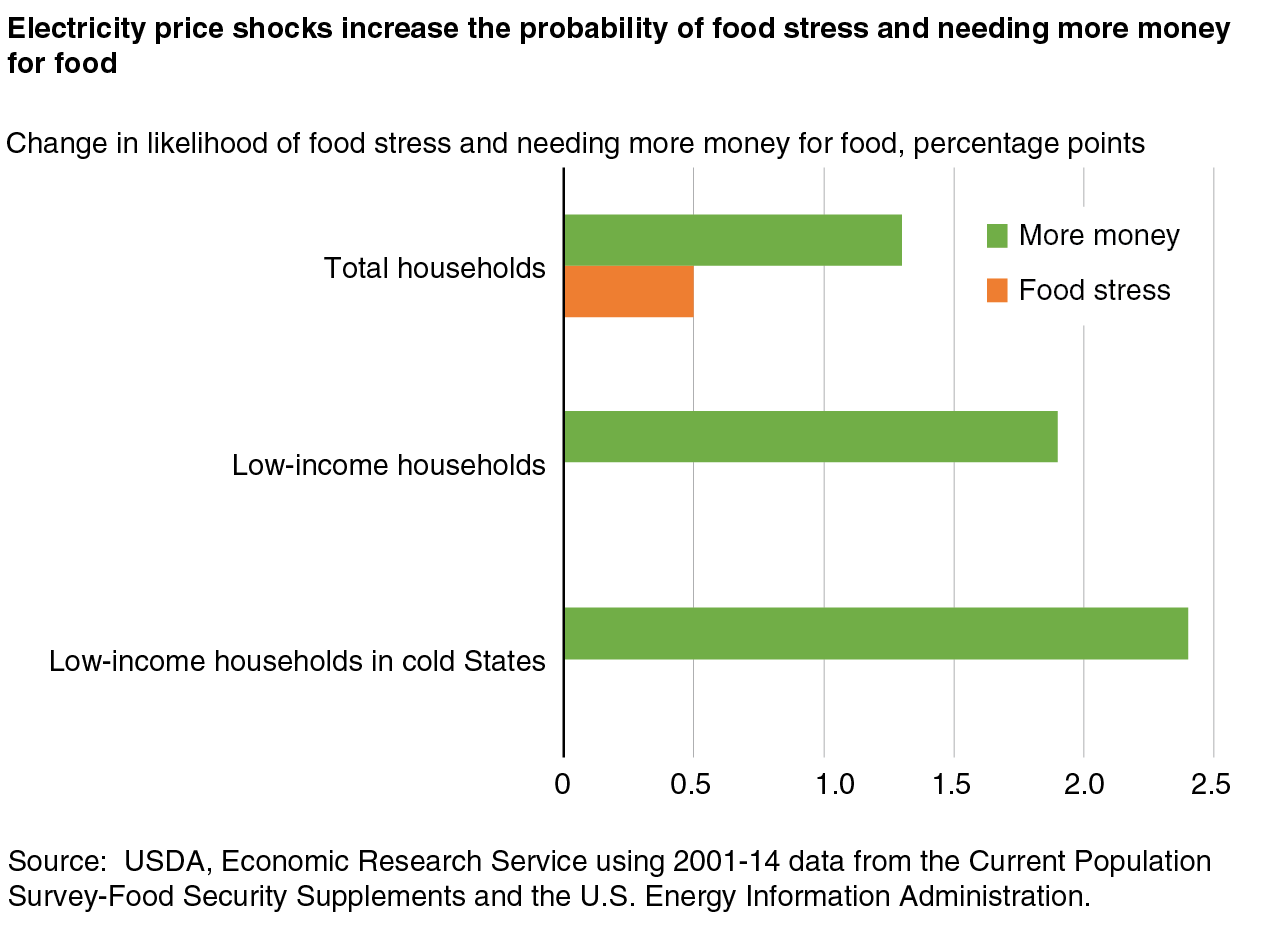Unexpected Hikes in Energy Prices Increase the Likelihood of Food Insecurity
- by Charlotte Tuttle
- 7/13/2017
Highlights
- Previous research has indicated that low-income households decrease the amount of food they buy in response to an increase in prices for gasoline, natural gas, and electricity.
- ERS extended this research to determine if unexpected increases in energy prices cause households to experience food insecurity and related indicators of food hardships.
- A 41-percent increase in natural gas prices led to the prevalence of food insecurity among low-income households rising from 12.4 to 14.7 percent.
A food-secure household is defined as one with access to sufficient food for all its members to lead active, healthy lives. A food-insecure household, on the other hand, does not have the resources to acquire enough food for some or all of its members. Food-insecure households may skip meals, cut the size of meals, or compromise the nutritional quality of meals due to cost. During 2000-07, U.S. food insecurity rates ranged between 10 and 12 percent. After the Nation’s financial crisis hit in late 2007, 15 percent of U.S. households were food insecure. The U.S. food insecurity rate remained between 14 and 15 percent, before falling to 12.7 percent in 2015.
Food insecurity raises concerns because it can have lasting health consequences for members of affected households. Research has found that food-insecure adults are more likely to suffer diabetes, obesity, and depression. Children living in food-insecure homes face higher risks of iron deficiency anemia; more frequent stomach aches, headaches, and cold; and are more prone to developmental and academic problems.
Unexpected increases in energy prices (also called energy price shocks) can adversely affect food security; purchasing food and gasoline and paying utility bills compete for the same limited resources of low-income households. For poor families, rising energy prices create a difficult tradeoff between buying enough food, staying warm, or having enough gas for the car. Energy price shocks may be particularly detrimental to low-income households because they have fewer resources available to absorb the unplanned higher expense. While previous research has indicated that low-income households reduce the amount of food they buy in response to unexpected increases in energy prices, it is not clear whether these price shocks are large enough to dent a family’s food security.
A recent ERS study explored the relationship between energy price shocks and food security, as well as two other measures of food hardship or distress, and found that price shocks in each energy source in the analysis—gasoline, natural gas, and electricity—caused an increase in the probability of a household becoming food insecure and/or experiencing two other food-distress indicators. The magnitude of the response was higher for low-income households compared to the average response for all households.
Food Distress Measured Three Ways
The ERS study looked at the effects of energy price shocks on three measures of food distress using December 2001-14 data from the Food Security Supplement of the U.S. Census Bureau’s Current Population Survey (CPS). The three measures of food distress examined were based on responses to CPS questions related to food purchasing or consumption obstacles:
- Food insecurity—a household considered food insecure provided affirmative answers to 3 or more questions in an 18-item questionnaire about food-insecure conditions in the previous 30 days
- Food stress—a household experiencing food stress reported that it had “enough food but not always the kinds of food we want to eat, sometimes not enough to eat, or often not enough to eat”
- More money—a household that reported needing more money for food indicated it needs to spend more than it does now in order to buy just enough food to meet the household’s food needs
Price shocks for each of the three energy sources were derived from State-level data from the U.S. Energy Information Administration over the time period 2000 through 2014. Shocks are defined as significant increases from what the households expected to pay given the information they had available at the time.
The study analyzed three overlapping samples from the survey: all households, households at or under 185 percent of the Federal poverty line (low-income households), and low-income households that reside in cold States—defined as the 26 States (among the 48 contiguous States) with the coldest average temperatures in December for 2000-14.
Food insecurity rates for low-income households and low-income households that reside in cold States were 12.4 percent and 11.7 percent, respectively; 40.7 percent of low-income households and 38.7 percent of low-income households in cold States indicated food stress; and 24.3 percent of low-income households and 22.5 percent of low-income households that reside in cold States reported needing more money for food.
Unexpected Increases in Energy Prices Raised the Likelihood of Food Distress
The ERS analysis considered three energy sources: gasoline, natural gas, and electricity. Unexpected price increases for each energy source affected at least one food-distress indicator for each sample of households. Natural gas price shocks had the most consistent effects on all households and low-income households, increasing the likelihood of each indicator for all households and low-income households. Gasoline price shocks, however, had a less consistent effect, increasing the likelihood of needing more money for food in each sample but not increasing the other measures of food distress.
Gasoline is used primarily for transportation. Gasoline prices demonstrate volatility throughout the year, and price increases are unpredictable and more salient than other energy sources. The average size of the gasoline price shock analyzed was a 38-percent increase to the average expected price. This gasoline price shock was associated with a 3.1-percentage point increase in the probability of needing more money for food in the total sample and a 7.3-percentage point increase in the low-income sample. Gasoline price increases were not associated with changes in the probability of the other two measures of food distress for the total sample and the low-income sample. The impact of a gasoline price shock was not analyzed for the sample of low-income households in cold States.
Natural gas is the primary energy source for heating homes in the Northeast, Midwest, and West. Natural gas can also be used for powering water heaters and for cooking in homes. Natural gas price shocks over the years 2000-14 increased the probability of each food-distress indicator for the total sample and low-income sample. The magnitude of the effect was greater in the low-income sample, likely reflecting low-income households’ more constrained budgets.
Unexpected price increases for natural gas, which on average for the 14 years of the analysis were 41 percent of the expected price, increased the probability of needing more money for food by 1.0 percentage point in the total sample and by 1.4 percentage points in the low-income sample. The shocks also increased the probability of food stress by 1.2 percentage points in the total sample and 2.2 percentage points in the low-income sample. Natural gas price shocks increased the probability of food insecurity by 2.3 percentage points in the low-income sample, more than double the response of the total sample. Unexpected price increases for natural gas did not affect the food distress indicators for low-income households in cold States.
Electricity is the primary heating source in Southern States. Electricity prices tend to vary widely over States, but are relatively stable from year to year. The report indicated that electricity price shocks increase the probability of food stress and needing more money for food, but has no effect on food insecurity. The report found that electricity price shocks, which averaged 40 percent of the expected price, increased the probability of food stress by 0.5 percentage points for all households and needing more money for food by 1.3 percentage points. Electricity price shocks also increased the probability of needing more money for food by 1.9 percentage points in low-income households and 2.4 percentage points in the low-income households that reside in cold States. Unexpected increases in electricity prices did not increase the probability of food stress for the low-income households in the sample.
Other Assistance Programs May Lessen the Effects of Energy Price Shocks
When energy prices rise unexpectedly, low-income households face difficult budget decisions. Poor households often lack the savings, assets, and income to protect themselves from price shocks. These households may have to choose between paying heating bills and buying food when facing unexpected increases in energy prices.
ERS research suggests that energy price shocks can lead to higher rates of food insecurity and food hardship among low-income households. A 38-percent increase in gasoline prices was found to increase the likelihood of low-income households needing more money for food by 7.3 percentage points. Similarly sized price shocks for natural gas and electricity also affected food distress measures. As examples, an unexpected increase in the price of electricity raised the likelihood of low-income households needing more money for food by around 2 percentage points. And, natural gas price shocks were found to increase the likelihood of low-income households experiencing food insecurity by 2.3 percentage points.
That the impacts of energy price shocks were not larger suggests that Federal assistance programs, such as the Supplemental Nutrition Assistance Program (SNAP) and the Low Income Home Energy Assistance Program, might have played a role in helping poor families cope with unexpected increases in energy prices.
This article is drawn from:
- Tuttle, C. & Beatty, T.K.M. (2017). The Effects of Energy Price Shocks on Household Food Security in Low-Income Households. U.S. Department of Agriculture, Economic Research Service. ERR-233.


